|
|
Order by Related
- New Release
- Rate
Results in Title For pix import for rhino
 | PIX Import for Rhino is a plug-in for Rhino. This plug-in gives Rhino the ability to import graphical data from PIX files.
PIX files are the native file format of a digitizer software called Dr. Picza which comes bundled with Roland DG digitizers. PIX Import for Rhino gives Rhino the ability to import the digitized data from PIX files. You can import the data as points, lines, polylines, nurb curves, faces or nurb surfaces.
PIX Import for Rhino is very easy to use as it adds a new file type to the Rhino File Open dialog box. To import a XYZ file select Open from the File menu. Select "Dr. Picza Files (*.pix)" from the "File of type" combo box and select a PIX file to import. A new drawing will be created containing the imported PIX file. .. |
|
 | HPGL Import for Rhino is a plug-in for Rhino. This plug-in gives Rhino the ability to import graphical data from HPGL Plot (PLT) files.
HPGL is the Hewlett Packard Graphics Language designed for specifying 2D graphical information for the HP range of plotters. It was not intended as an interchange format but some software suppliers use it as such. HPGL is a command set embedded in the ROM of pen plotters to help reduce the work required by applications programmers to create plotted output. HPGL uses two-letter mnemonics as instructions for drawing lines, circles, text, and simple symbols.
HPGL plot files contain information regarding the movement of the pen of the HP plotter. HPGL Import for Rhino converts these pen movements into Rhino entities and adds them to the contents of a new Rhino drawing. HPGL Import for Rhino supports plot files created by drivers for the following plotters:
Hewlett-Packard 7475A
Hewlett-Packard 7550A
Hewlett-Packard 7580B
Hewlett-Packard 7585B
Hewlett-Packard 7586B
Hewlett-Packard Draftmaster 1 (7595A)
Hewlett-Packard Draftmaster 2 (7596A)
Hewlett-Packard Draftpro (7570A)
Hewlett-Packard Draftpro-DXL (7575A)
Hewlett-Packard Draftpro-EXL (7576A)
HPGL Import for Rhino is very easy to use as it adds a new file type to the Rhino File Open dialog box. To import a PLT file select Open from the File menu. Select "HPGL Plot Files (*.plt)" from the "File of type" combo box and select a PLT file to import. A new drawing will be created containing the imported PLT file. ..
|
|
 | NC Import for Rhino is a plug-in for Rhino. This plug-in gives Rhino the ability to import commands from NC files.
CNC Machines worldwide use Numeric Control files (.nc or .ncc) to convert programmed instructions to tool movement. NC programs consist of a sequence of codes with parameter data to arrive at a precise description of the toolpath. But the best of NC programmers also can make mistakes. NC Import for Rhino lets you import NC files into Rhino so that you can view the intended toolpath in 3D.
NC Import for Rhino is very easy to use as it adds a new file type to the Rhino File Open dialog box. To import a NC file select Open from the File menu. Select "Numeric Control Files (*.nc,*.ncc)" from the "File of type" combo box and select a NC file to import. A new drawing will be created containing the imported NC file. .. |
|
 | OBJ Import for Rhino is a plug-in for Rhino. This plug-in gives Rhino the ability to import graphical data from ASCII Alias|Wavefront OBJ files.
Alias|Wavefront is the world's leading innovator of 2D/3D graphics technology for the film, video, games, interactive media, industrial design, automotive industry and visualization markets. Their .OBJ ASCII file format is widely accepted the world over for exchanging graphical data between drafting applications.
OBJ files contain solids which are made up of 3 or 4 sided faces. OBJ Import for Rhino converts these faces into a single Rhino Polygon Mesh entity and adds it to the contents of a new Rhino drawing.
OBJ Import for Rhino is very easy to use as it adds a new file type to the Rhino File Open dialog box. To import an OBJ file select Open from the File menu. Select "Wavefront Files (*.obj)" from the "File of type" combo box and select an OBJ file to import. A new drawing will be created containing the imported OBJ file. ..
|
|
 | PIX Import for AutoCAD is a plug-in for AutoCAD 2000, 2000i, 2002 and 2004. This plug-in gives AutoCAD the ability to import geometric data from PIX files.
PIX files are the native file format of a digitizer software called Dr. Picza which comes bundled with Roland DG digitizers. PIX Import for AutoCAD gives AutoCAD the ability to import data from PIX files. You can import the data as points, lines, polylines, splines, faces, polyface mesh or polygon mesh.
PIX Import for AutoCAD is very easy to use. It adds a new command to AutoCAD called "PIXIN". Simply type "PIXIN" at the AutoCAD command prompt and select a PIX file to import. .. |
|
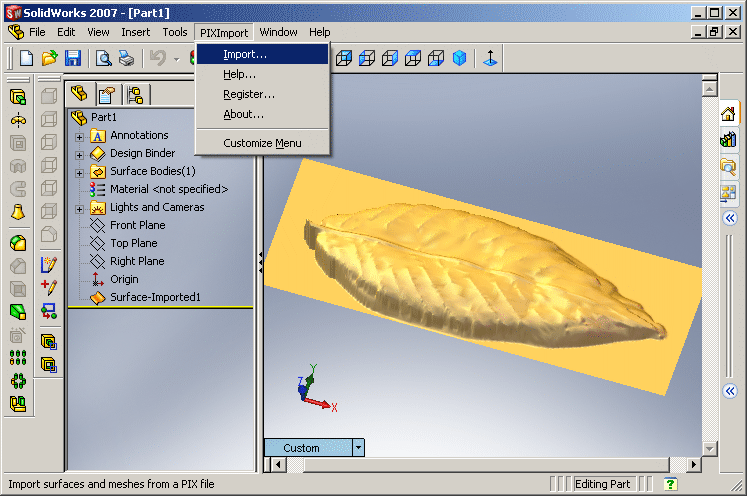 | PIX Import for SolidWorks is a Dr. Picza (.pix) file import add-in for SolidWorks ..
|
|
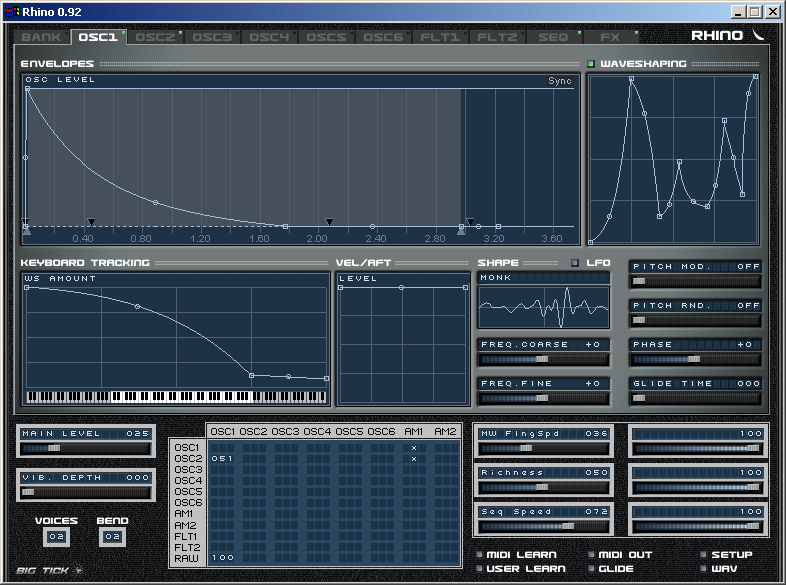 | Powerful virtual synthesizer plugin with 6 oscillators per voice, a huge selection of waveforms, graphical multipoint envelopes with curvature controls (sync-able to tempo) , dual multimode filters, waveshaper, built-in effects, ... .. |
|
 | MeshWorks for Rhino is a plug-in for Rhino. It adds a variety of mesh manipulation commands to Rhino. Some of the useful commands are given below:
Hollow: This command hollows the mesh to a given wall thickness. Hollowing is particularly useful while preparing a model for Rapid Prototyping as it saves material, time and money while building a prototype.
Offset: This command offsets a mesh to either shrink or expand it.
PointsToMesh: This command creates a mesh from a set of points.
Stitch: This command knits loosely tied faces of a mesh and attempts to make a mesh water-tight.
FillHoles: This command adds faces to an existing mesh in order to fill any holes. The result is a water-tight mesh.
ExtractSolid: This command extracts a solid from a mesh.
ExtractPlanarSurfaces: This command extracts a planar trimmed NURBS surface from a mesh.
ExtractShells: This command extracts connected surfaces from a single mesh and creates a new mesh for each connected surface. This is useful while working on different parts of a mesh.
ExtractSurfaces: This command extracts surfaces of a mesh and creates a new mesh for each surface.
ExtractFeatures: This command extracts features of a mesh. This is useful to create a NURBS model from a polygon mesh.
ExtractBoundaries: This command extracts the boundaries of an open mesh.
SplitMesh: This command splits a mesh with a planar surface into two parts.
Smoothen: This command relaxes a mesh by removing sharp edges.
Decimate: This command reduces the number of faces of a mesh while maintaining continuity in the topology.
MeshWorks for Rhino adds a new menu to the existing Rhino menu containing all the added commands. Simply use this menu to manipulate meshes. .. |
|
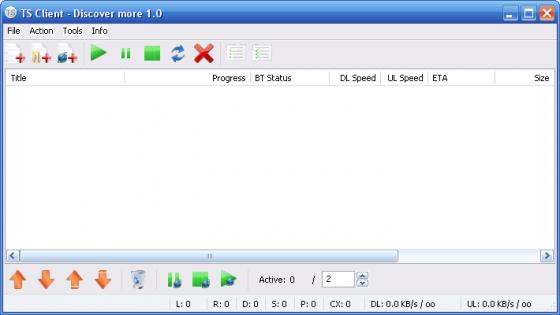 | Terrain for Rhino is a terrain modeling plug-in for Rhinoceros (commonly known as Rhino). This plug-in gives Rhino the ability to create a terrain mesh from a set of unordered points. The terrain mesh is created as a Delaunay Triangulation, which is regarded as the best method to create a terrain mesh from unorganized point data. Terrain for Rhino is powered by PointLib, a state of the art terrain modeling library developed by SYCODE.
Terrain for Rhino is designed to be extremely user friendly and easy to use. The plug-in adds a new command to Rhino called Terrain. The Terrain command has a single parameter called Search Radius. The search radius determines the whether two points can be part of the same triangular face. If the distance between two points is larger than the search radius then they are not connected by a face. A search radius of zero will remove the connectivity constraint and all points will be connected, however far they may be from each other. The Terrain command is scriptable so that you can add it to a script to automate your modeling tasks. .. |
|
 | Point Cloud for Rhino is a plug-in for Rhino 2.0 and 3.0. This plug-in gives Rhino the ability to process point clouds. You can import a point cloud into Rhino as it is or fit a surface that passes through the points to recreate the original object. This is ideal for reverse engineering and GIS applications. There are different ways of fitting a surface depending on the nature of the point cloud.
Point Cloud for Rhino also has the ability to compensate for probe diameter. There is an inherent error with probe based scanners since they digitize points at the center of the probe. Point Cloud for Rhino takes care of this very efficiently.
Point Cloud for Rhino has a wizard that helps you process point clouds. When working with the wizard you can switch to "Expert" mode at any time.
Point Cloud for Rhino is very easy to use. It adds a new command to Rhino called "PC". Simply type "PC" at the command prompt and follow the simple instructions. .. |
|
Results in Keywords For pix import for rhino
 | NC Import for Rhino is a plug-in for Rhino. This plug-in gives Rhino the ability to import commands from NC files.
CNC Machines worldwide use Numeric Control files (.nc or .ncc) to convert programmed instructions to tool movement. NC programs consist of a sequence of codes with parameter data to arrive at a precise description of the toolpath. But the best of NC programmers also can make mistakes. NC Import for Rhino lets you import NC files into Rhino so that you can view the intended toolpath in 3D.
NC Import for Rhino is very easy to use as it adds a new file type to the Rhino File Open dialog box. To import a NC file select Open from the File menu. Select "Numeric Control Files (*.nc,*.ncc)" from the "File of type" combo box and select a NC file to import. A new drawing will be created containing the imported NC file... |
|
 | OBJ Import for Rhino is a plug-in for Rhino. This plug-in gives Rhino the ability to import graphical data from ASCII Alias|Wavefront OBJ files.
Alias|Wavefront is the world's leading innovator of 2D/3D graphics technology for the film, video, games, interactive media, industrial design, automotive industry and visualization markets. Their .OBJ ASCII file format is widely accepted the world over for exchanging graphical data between drafting applications.
OBJ files contain solids which are made up of 3 or 4 sided faces. OBJ Import for Rhino converts these faces into a single Rhino Polygon Mesh entity and adds it to the contents of a new Rhino drawing.
OBJ Import for Rhino is very easy to use as it adds a new file type to the Rhino File Open dialog box. To import an OBJ file select Open from the File menu. Select "Wavefront Files (*.obj)" from the "File of type" combo box and select an OBJ file to import. A new drawing will be created containing the imported OBJ file...
|
|
 | PIX Import for Rhino is a plug-in for Rhino. This plug-in gives Rhino the ability to import graphical data from PIX files.
PIX files are the native file format of a digitizer software called Dr. Picza which comes bundled with Roland DG digitizers. PIX Import for Rhino gives Rhino the ability to import the digitized data from PIX files. You can import the data as points, lines, polylines, nurb curves, faces or nurb surfaces.
PIX Import for Rhino is very easy to use as it adds a new file type to the Rhino File Open dialog box. To import a XYZ file select Open from the File menu. Select "Dr. Picza Files (*.pix)" from the "File of type" combo box and select a PIX file to import. A new drawing will be created containing the imported PIX file... |
|
 | HPGL Import for Rhino is a plug-in for Rhino. This plug-in gives Rhino the ability to import graphical data from HPGL Plot (PLT) files.
HPGL is the Hewlett Packard Graphics Language designed for specifying 2D graphical information for the HP range of plotters. It was not intended as an interchange format but some software suppliers use it as such. HPGL is a command set embedded in the ROM of pen plotters to help reduce the work required by applications programmers to create plotted output. HPGL uses two-letter mnemonics as instructions for drawing lines, circles, text, and simple symbols.
HPGL plot files contain information regarding the movement of the pen of the HP plotter. HPGL Import for Rhino converts these pen movements into Rhino entities and adds them to the contents of a new Rhino drawing. HPGL Import for Rhino supports plot files created by drivers for the following plotters:
Hewlett-Packard 7475A
Hewlett-Packard 7550A
Hewlett-Packard 7580B
Hewlett-Packard 7585B
Hewlett-Packard 7586B
Hewlett-Packard Draftmaster 1 (7595A)
Hewlett-Packard Draftmaster 2 (7596A)
Hewlett-Packard Draftpro (7570A)
Hewlett-Packard Draftpro-DXL (7575A)
Hewlett-Packard Draftpro-EXL (7576A)
HPGL Import for Rhino is very easy to use as it adds a new file type to the Rhino File Open dialog box. To import a PLT file select Open from the File menu. Select "HPGL Plot Files (*.plt)" from the "File of type" combo box and select a PLT file to import. A new drawing will be created containing the imported PLT file...
|
|
 | Point Cloud for Rhino is a plug-in for Rhino 2.0 and 3.0. This plug-in gives Rhino the ability to process point clouds. You can import a point cloud into Rhino as it is or fit a surface that passes through the points to recreate the original object. This is ideal for reverse engineering and GIS applications. There are different ways of fitting a surface depending on the nature of the point cloud.
Point Cloud for Rhino also has the ability to compensate for probe diameter. There is an inherent error with probe based scanners since they digitize points at the center of the probe. Point Cloud for Rhino takes care of this very efficiently.
Point Cloud for Rhino has a wizard that helps you process point clouds. When working with the wizard you can switch to "Expert" mode at any time.
Point Cloud for Rhino is very easy to use. It adds a new command to Rhino called "PC". Simply type "PC" at the command prompt and follow the simple instructions... |
|
 | Terrain for Rhino is a terrain modeling plug-in for Rhinoceros (commonly known as Rhino). This plug-in gives Rhino the ability to create a terrain mesh from a set of unordered points. The terrain mesh is created as a Delaunay Triangulation, which is regarded as the best method to create a terrain mesh from unorganized point data. Terrain for Rhino is powered by PointLib, a state of the art terrain modeling library developed by SYCODE.
Terrain for Rhino is designed to be extremely user friendly and easy to use. The plug-in adds a new command to Rhino called Terrain. The Terrain command has a single parameter called Search Radius. The search radius determines the whether two points can be part of the same triangular face. If the distance between two points is larger than the search radius then they are not connected by a face. A search radius of zero will remove the connectivity constraint and all points will be connected, however far they may be from each other. The Terrain command is scriptable so that you can add it to a script to automate your modeling tasks...
|
|
 | MeshWorks for Rhino is a plug-in for Rhino. It adds a variety of mesh manipulation commands to Rhino. Some of the useful commands are given below:
Hollow: This command hollows the mesh to a given wall thickness. Hollowing is particularly useful while preparing a model for Rapid Prototyping as it saves material, time and money while building a prototype.
Offset: This command offsets a mesh to either shrink or expand it.
PointsToMesh: This command creates a mesh from a set of points.
Stitch: This command knits loosely tied faces of a mesh and attempts to make a mesh water-tight.
FillHoles: This command adds faces to an existing mesh in order to fill any holes. The result is a water-tight mesh.
ExtractSolid: This command extracts a solid from a mesh.
ExtractPlanarSurfaces: This command extracts a planar trimmed NURBS surface from a mesh.
ExtractShells: This command extracts connected surfaces from a single mesh and creates a new mesh for each connected surface. This is useful while working on different parts of a mesh.
ExtractSurfaces: This command extracts surfaces of a mesh and creates a new mesh for each surface.
ExtractFeatures: This command extracts features of a mesh. This is useful to create a NURBS model from a polygon mesh.
ExtractBoundaries: This command extracts the boundaries of an open mesh.
SplitMesh: This command splits a mesh with a planar surface into two parts.
Smoothen: This command relaxes a mesh by removing sharp edges.
Decimate: This command reduces the number of faces of a mesh while maintaining continuity in the topology.
MeshWorks for Rhino adds a new menu to the existing Rhino menu containing all the added commands. Simply use this menu to manipulate meshes... |
|
 | HPGL Export for Rhino is a HPGL plot file export plug-in for Rhino. This plug-in gives Rhino the ability to export geometric data from Rhino to HPGL Plot (PLT) files.
HPGL is the Hewlett Packard Graphics Language designed for specifying 2D graphical information for the HP range of plotters. It was not intended as an interchange format but some software suppliers use it as such. HPGL is a command set embedded in the ROM of pen plotters to help reduce the work required by applications programmers to create plotted output. HPGL uses two-letter mnemonics as instructions for drawing lines, circles, text, and simple symbols.
HPGL Export for Rhino breaks down Rhino entities into pen movements and writes them to the output plot file. HPGL Export for Rhino supports the following plotters:
Hewlett-Packard 7475A
Hewlett-Packard 7550A
Hewlett-Packard 7580B
Hewlett-Packard 7585B
Hewlett-Packard 7586B
Hewlett-Packard Draftmaster 1 (7595A)
Hewlett-Packard Draftmaster 2 (7596A)
Hewlett-Packard Draftpro (7570A)
Hewlett-Packard Draftpro-DXL (7575A)
Hewlett-Packard Draftpro-EXL (7576A)
HPGL Export for Rhino is very easy to use as it adds a new file type to the Rhino File Save As dialog box. To export a PLT file select Save As from the File menu. Select "HPGL Plot Files (*.plt)" from the "File of type" combo box and select a PLT file to export to... |
|
 | Mesh To Solid for Rhino is a plug-in for Rhino 2.0 and 3.0. This plug-in gives Rhino to ability to convert a mesh into a solid.
A mesh is a useful entity when it comes to defining geometry of an object. However, certain Rhino commands such as boolean operations, offset, extrusion, etc, cannot be performed on meshes. Moreover, Rhino does not export meshes to IGES, STEP, ACIS, ParaSolid, VDA and similar file formats, thereby rendering the mesh model useless for further solid modeling in another CAD system. Rhino imports STL, OBJ and other similar files as meshes only. If you need to modify these imported objects you need to convert them into solids.
Rhino has an internal "MeshToNurb" command. This command converts each and every face of the mesh into a Nurbs surface and joins them together. This makes the final solid object complicated and difficult to work with.
Mesh To Solid for Rhino, on the other hand, studies the mesh object and determines the features that define the geometry of the model. It then creates a single trimmed Nurbs surface for a group of mesh faces that collectively define a feature. Finally it joins all the trimmed Nurbs surfaces to form the final solid. The resulting solid contains a far lesser number of faces and is much easier to work with.
Mesh To Solid for Rhino is very easy to use. It adds a new command to Rhino called "MeshToSolid". Simply type "MeshToSolid" at the command prompt and select the mesh you wish to convert into a solid... |
|
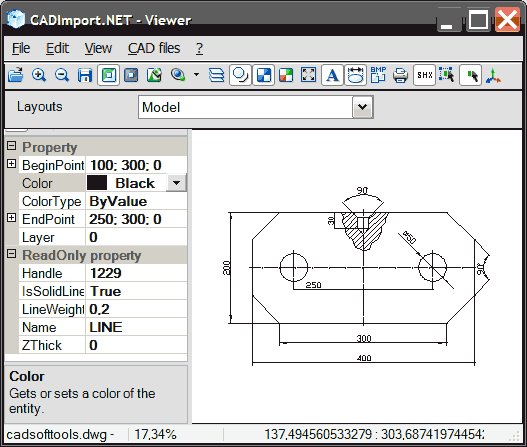 | CAD Import .NET is an easy-to-use API for reading AutoCAD DWG / DXF, PLT, HPGL and CGM in C#, VB.NET, J# and Delphi .NET applications. DWG 2007/2008 is supported. It is programmed completely in C# and supports the following entities:
3dFace
Arc
Attdef
Block
BlockRecord
Circle
Dimension
Ellipse
Hatch
Insert
Layer
Layout
Line
LWPolyline
MText
TableItem
Polyline
Solid
Style
Table
Text
Viewport
and more..
And properties:
Extrusion
LineType
Color
3D rotation
and more..
The package consists of demos for C#, VB.NET, J#, along with help and license information. The Viewer demo shows how to use the product for viewing DXF/DWG, zooming and exporting to BMP and JPEG, etc.
The Import demo explains access to the extensive properties of each CAD entity which is supported by CAD Import .NET.
The program supports the following raster format extensions: *.bmp, *.jpg, *.jpeg, *.tiff, *.gif and *.ico... |
|
Results in Description For pix import for rhino
 | HPGL Import for Rhino is a plug-in for Rhino. This plug-in gives Rhino the ability to import graphical data from HPGL Plot (PLT) files.
HPGL is the Hewlett Packard Graphics Language designed for specifying 2D graphical information for the HP range of plotters. It was not intended as an interchange format but some software suppliers use it as such. HPGL is a command set embedded in the ROM of pen plotters to help reduce the work required by applications programmers to create plotted output. HPGL uses two-letter mnemonics as instructions for drawing lines, circles, text, and simple symbols.
HPGL plot files contain information regarding the movement of the pen of the HP plotter. HPGL Import for Rhino converts these pen movements into Rhino entities and adds them to the contents of a new Rhino drawing. HPGL Import for Rhino supports plot files created by drivers for the following plotters:
Hewlett-Packard 7475A
Hewlett-Packard 7550A
Hewlett-Packard 7580B
Hewlett-Packard 7585B
Hewlett-Packard 7586B
Hewlett-Packard Draftmaster 1 (7595A)
Hewlett-Packard Draftmaster 2 (7596A)
Hewlett-Packard Draftpro (7570A)
Hewlett-Packard Draftpro-DXL (7575A)
Hewlett-Packard Draftpro-EXL (7576A)
HPGL Import for Rhino is very easy to use as it adds a new file type to the Rhino File Open dialog box. To import a PLT file select Open from the File menu. Select "HPGL Plot Files (*.plt)" from the "File of type" combo box and select a PLT file to import. A new drawing will be created containing the imported PLT file... |
|
 | PIX Import for SolidWorks is a Dr. Picza (.pix) file import add-in for SolidWorks..
|
|
 | Terrain for Rhino is a terrain modeling plug-in for Rhinoceros (commonly known as Rhino). This plug-in gives Rhino the ability to create a terrain mesh from a set of unordered points. The terrain mesh is created as a Delaunay Triangulation, which is regarded as the best method to create a terrain mesh from unorganized point data. Terrain for Rhino is powered by PointLib, a state of the art terrain modeling library developed by SYCODE.
Terrain for Rhino is designed to be extremely user friendly and easy to use. The plug-in adds a new command to Rhino called Terrain. The Terrain command has a single parameter called Search Radius. The search radius determines the whether two points can be part of the same triangular face. If the distance between two points is larger than the search radius then they are not connected by a face. A search radius of zero will remove the connectivity constraint and all points will be connected, however far they may be from each other. The Terrain command is scriptable so that you can add it to a script to automate your modeling tasks... |
|
 | Mesh To Solid for Rhino is a plug-in for Rhino 2.0 and 3.0. This plug-in gives Rhino to ability to convert a mesh into a solid.
A mesh is a useful entity when it comes to defining geometry of an object. However, certain Rhino commands such as boolean operations, offset, extrusion, etc, cannot be performed on meshes. Moreover, Rhino does not export meshes to IGES, STEP, ACIS, ParaSolid, VDA and similar file formats, thereby rendering the mesh model useless for further solid modeling in another CAD system. Rhino imports STL, OBJ and other similar files as meshes only. If you need to modify these imported objects you need to convert them into solids.
Rhino has an internal "MeshToNurb" command. This command converts each and every face of the mesh into a Nurbs surface and joins them together. This makes the final solid object complicated and difficult to work with.
Mesh To Solid for Rhino, on the other hand, studies the mesh object and determines the features that define the geometry of the model. It then creates a single trimmed Nurbs surface for a group of mesh faces that collectively define a feature. Finally it joins all the trimmed Nurbs surfaces to form the final solid. The resulting solid contains a far lesser number of faces and is much easier to work with.
Mesh To Solid for Rhino is very easy to use. It adds a new command to Rhino called "MeshToSolid". Simply type "MeshToSolid" at the command prompt and select the mesh you wish to convert into a solid...
|
|
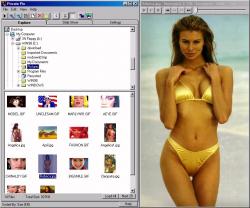 | Private Pix utilizes new technologies to keep your pictures and movies safe while keeping them password protected and encrypted. Advanced security features include name scrambling and variable key length. Private Pix has an easy to use interface that makes organizing and viewing of your pictures easier than ever before. Try Private Pix worry free as it does not change any system settings... |
|
 | HPGL Export for Rhino is a HPGL plot file export plug-in for Rhino. This plug-in gives Rhino the ability to export geometric data from Rhino to HPGL Plot (PLT) files.
HPGL is the Hewlett Packard Graphics Language designed for specifying 2D graphical information for the HP range of plotters. It was not intended as an interchange format but some software suppliers use it as such. HPGL is a command set embedded in the ROM of pen plotters to help reduce the work required by applications programmers to create plotted output. HPGL uses two-letter mnemonics as instructions for drawing lines, circles, text, and simple symbols.
HPGL Export for Rhino breaks down Rhino entities into pen movements and writes them to the output plot file. HPGL Export for Rhino supports the following plotters:
Hewlett-Packard 7475A
Hewlett-Packard 7550A
Hewlett-Packard 7580B
Hewlett-Packard 7585B
Hewlett-Packard 7586B
Hewlett-Packard Draftmaster 1 (7595A)
Hewlett-Packard Draftmaster 2 (7596A)
Hewlett-Packard Draftpro (7570A)
Hewlett-Packard Draftpro-DXL (7575A)
Hewlett-Packard Draftpro-EXL (7576A)
HPGL Export for Rhino is very easy to use as it adds a new file type to the Rhino File Save As dialog box. To export a PLT file select Save As from the File menu. Select "HPGL Plot Files (*.plt)" from the "File of type" combo box and select a PLT file to export to...
|
|
 | MeshWorks for Rhino is a plug-in for Rhino. It adds a variety of mesh manipulation commands to Rhino. Some of the useful commands are given below:
Hollow: This command hollows the mesh to a given wall thickness. Hollowing is particularly useful while preparing a model for Rapid Prototyping as it saves material, time and money while building a prototype.
Offset: This command offsets a mesh to either shrink or expand it.
PointsToMesh: This command creates a mesh from a set of points.
Stitch: This command knits loosely tied faces of a mesh and attempts to make a mesh water-tight.
FillHoles: This command adds faces to an existing mesh in order to fill any holes. The result is a water-tight mesh.
ExtractSolid: This command extracts a solid from a mesh.
ExtractPlanarSurfaces: This command extracts a planar trimmed NURBS surface from a mesh.
ExtractShells: This command extracts connected surfaces from a single mesh and creates a new mesh for each connected surface. This is useful while working on different parts of a mesh.
ExtractSurfaces: This command extracts surfaces of a mesh and creates a new mesh for each surface.
ExtractFeatures: This command extracts features of a mesh. This is useful to create a NURBS model from a polygon mesh.
ExtractBoundaries: This command extracts the boundaries of an open mesh.
SplitMesh: This command splits a mesh with a planar surface into two parts.
Smoothen: This command relaxes a mesh by removing sharp edges.
Decimate: This command reduces the number of faces of a mesh while maintaining continuity in the topology.
MeshWorks for Rhino adds a new menu to the existing Rhino menu containing all the added commands. Simply use this menu to manipulate meshes... |
|
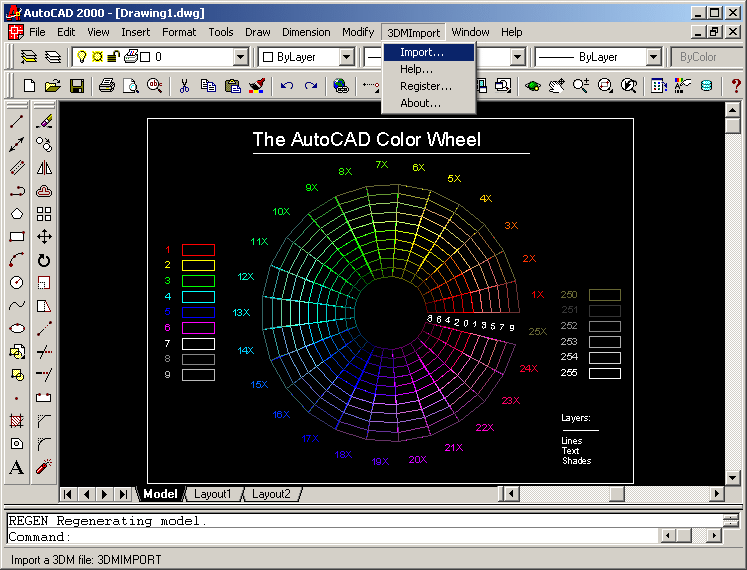 | 3DM Import for AutoCAD is a Rhino 3D Model / OpenNURBS 3DM file import plug-in for AutoCAD. This plug-in gives AutoCAD the ability to import geometric data from 3DM files.
3DM Import for AutoCAD offers seamless conversion of 3DM geometry to AutoCAD's DWG geometry. The integrity of layers, blocks, block instances or inserts, dimensions, etc. are maintained across the conversion. Optionally, polycurves, meshes and blocks can be exploded into simpler objects during the import.
The OpenNURBS Initiative was founded by Robert McNeel & Associates in January 2000, with the sole purpose of providing CAD, CAM, CAE and computer graphics software users reliable methods for transferring 3D geometry between applications via the 3DM (3D Model) file format. The 3DM file format is the native file format of Rhinoceros, the NURBS modeling software from McNeel. At SYCODE, we believe that the 3DM file format has tremendous potential and will go a long way to solve the data exchange problem of the CAD software industry. TerrainCAD, our terrain generation, editing and modeling software, also uses the 3DM file format as its native file format.
3DM Import for AutoCAD is very easy to use as it adds a new command to AutoCAD called 3DMImport. Simply type 3DMImport at the AutoCAD command prompt and select a 3DM file to import into the active AutoCAD drawing... |
|
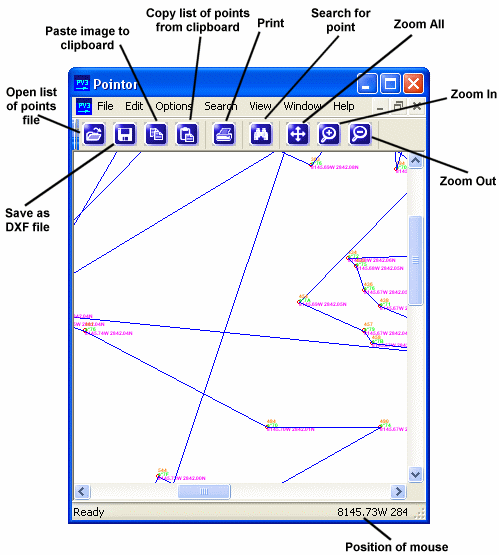 | Pointor imports lists of points (2D or 3D) shows them graphically and saves them as a DXF file. The DXF file can then be read by other applications, for example AutoCAD or Rhino. CSV to DXF functionality is included... |
|
 | Firewall RuleMaker is a Windows-based firewall configuration version control software product for managers of Cisco PIX and Netscreen firewalls... |
|
Results in Tags For pix import for rhino
 | PIX Import for Rhino is a plug-in for Rhino. This plug-in gives Rhino the ability to import graphical data from PIX files.
PIX files are the native file format of a digitizer software called Dr. Picza which comes bundled with Roland DG digitizers. PIX Import for Rhino gives Rhino the ability to import the digitized data from PIX files. You can import the data as points, lines, polylines, nurb curves, faces or nurb surfaces.
PIX Import for Rhino is very easy to use as it adds a new file type to the Rhino File Open dialog box. To import a XYZ file select Open from the File menu. Select "Dr. Picza Files (*.pix)" from the "File of type" combo box and select a PIX file to import. A new drawing will be created containing the imported PIX file... |
|
 | PIX Import for AutoCAD is a plug-in for AutoCAD 2000, 2000i, 2002 and 2004. This plug-in gives AutoCAD the ability to import geometric data from PIX files.
PIX files are the native file format of a digitizer software called Dr. Picza which comes bundled with Roland DG digitizers. PIX Import for AutoCAD gives AutoCAD the ability to import data from PIX files. You can import the data as points, lines, polylines, splines, faces, polyface mesh or polygon mesh.
PIX Import for AutoCAD is very easy to use. It adds a new command to AutoCAD called "PIXIN". Simply type "PIXIN" at the AutoCAD command prompt and select a PIX file to import...
|
|
 | OBJ Import for Rhino is a plug-in for Rhino. This plug-in gives Rhino the ability to import graphical data from ASCII Alias|Wavefront OBJ files.
Alias|Wavefront is the world's leading innovator of 2D/3D graphics technology for the film, video, games, interactive media, industrial design, automotive industry and visualization markets. Their .OBJ ASCII file format is widely accepted the world over for exchanging graphical data between drafting applications.
OBJ files contain solids which are made up of 3 or 4 sided faces. OBJ Import for Rhino converts these faces into a single Rhino Polygon Mesh entity and adds it to the contents of a new Rhino drawing.
OBJ Import for Rhino is very easy to use as it adds a new file type to the Rhino File Open dialog box. To import an OBJ file select Open from the File menu. Select "Wavefront Files (*.obj)" from the "File of type" combo box and select an OBJ file to import. A new drawing will be created containing the imported OBJ file... |
|
 | NC Import for Rhino is a plug-in for Rhino. This plug-in gives Rhino the ability to import commands from NC files.
CNC Machines worldwide use Numeric Control files (.nc or .ncc) to convert programmed instructions to tool movement. NC programs consist of a sequence of codes with parameter data to arrive at a precise description of the toolpath. But the best of NC programmers also can make mistakes. NC Import for Rhino lets you import NC files into Rhino so that you can view the intended toolpath in 3D.
NC Import for Rhino is very easy to use as it adds a new file type to the Rhino File Open dialog box. To import a NC file select Open from the File menu. Select "Numeric Control Files (*.nc,*.ncc)" from the "File of type" combo box and select a NC file to import. A new drawing will be created containing the imported NC file...
|
|
 | 3DM Import for AutoCAD is a Rhino 3D Model / OpenNURBS 3DM file import plug-in for AutoCAD. This plug-in gives AutoCAD the ability to import geometric data from 3DM files.
3DM Import for AutoCAD offers seamless conversion of 3DM geometry to AutoCAD's DWG geometry. The integrity of layers, blocks, block instances or inserts, dimensions, etc. are maintained across the conversion. Optionally, polycurves, meshes and blocks can be exploded into simpler objects during the import.
The OpenNURBS Initiative was founded by Robert McNeel & Associates in January 2000, with the sole purpose of providing CAD, CAM, CAE and computer graphics software users reliable methods for transferring 3D geometry between applications via the 3DM (3D Model) file format. The 3DM file format is the native file format of Rhinoceros, the NURBS modeling software from McNeel. At SYCODE, we believe that the 3DM file format has tremendous potential and will go a long way to solve the data exchange problem of the CAD software industry. TerrainCAD, our terrain generation, editing and modeling software, also uses the 3DM file format as its native file format.
3DM Import for AutoCAD is very easy to use as it adds a new command to AutoCAD called 3DMImport. Simply type 3DMImport at the AutoCAD command prompt and select a 3DM file to import into the active AutoCAD drawing... |
|
 | HPGL Import for Rhino is a plug-in for Rhino. This plug-in gives Rhino the ability to import graphical data from HPGL Plot (PLT) files.
HPGL is the Hewlett Packard Graphics Language designed for specifying 2D graphical information for the HP range of plotters. It was not intended as an interchange format but some software suppliers use it as such. HPGL is a command set embedded in the ROM of pen plotters to help reduce the work required by applications programmers to create plotted output. HPGL uses two-letter mnemonics as instructions for drawing lines, circles, text, and simple symbols.
HPGL plot files contain information regarding the movement of the pen of the HP plotter. HPGL Import for Rhino converts these pen movements into Rhino entities and adds them to the contents of a new Rhino drawing. HPGL Import for Rhino supports plot files created by drivers for the following plotters:
Hewlett-Packard 7475A
Hewlett-Packard 7550A
Hewlett-Packard 7580B
Hewlett-Packard 7585B
Hewlett-Packard 7586B
Hewlett-Packard Draftmaster 1 (7595A)
Hewlett-Packard Draftmaster 2 (7596A)
Hewlett-Packard Draftpro (7570A)
Hewlett-Packard Draftpro-DXL (7575A)
Hewlett-Packard Draftpro-EXL (7576A)
HPGL Import for Rhino is very easy to use as it adds a new file type to the Rhino File Open dialog box. To import a PLT file select Open from the File menu. Select "HPGL Plot Files (*.plt)" from the "File of type" combo box and select a PLT file to import. A new drawing will be created containing the imported PLT file...
|
|
 | PIX Import for SolidWorks is a Dr. Picza (.pix) file import add-in for SolidWorks.. |
|
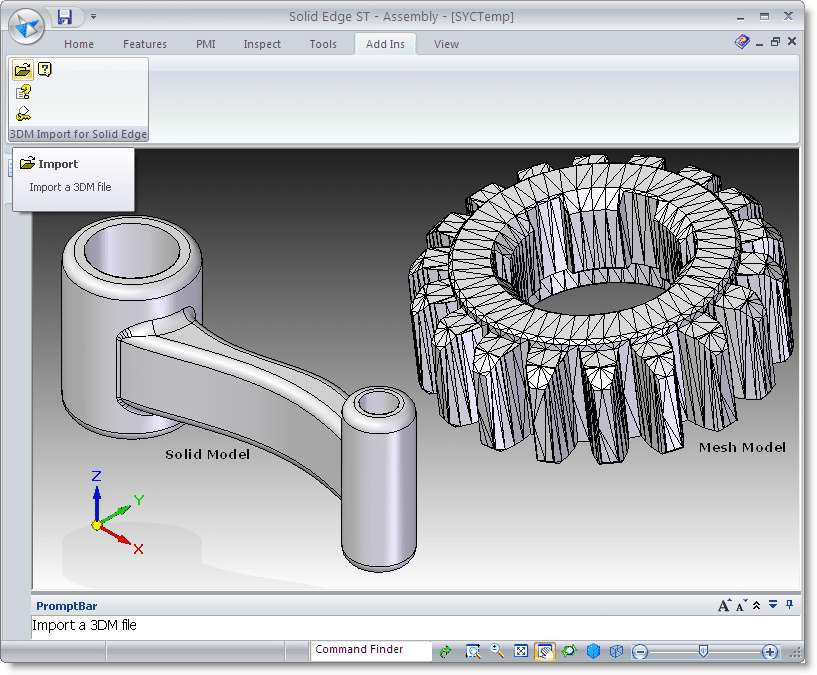 | 3DM Import for Solid Edge is a Rhinoceros (.3dm) file import add-in for Solid Edge.. |
|
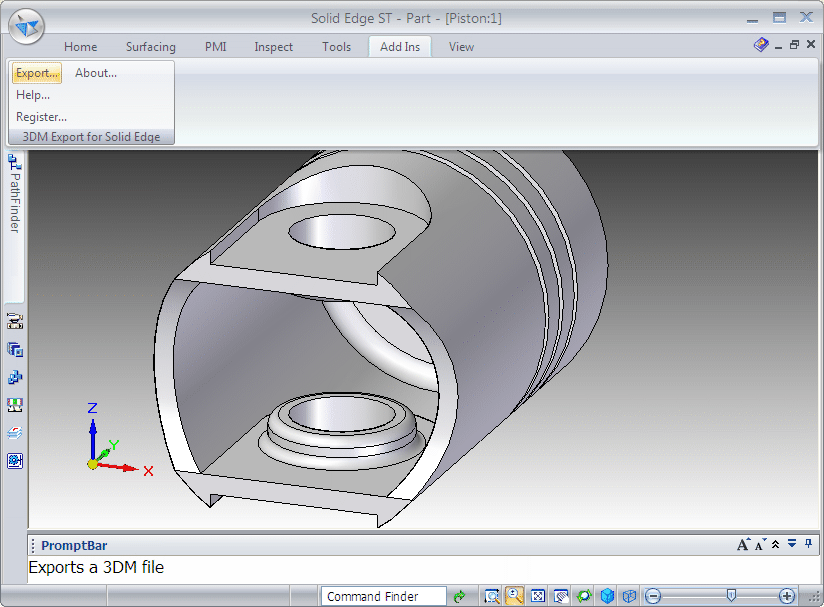 | 3DM Export for Solid Edge is a Rhinoceros (.3dm) file export add-in for Solid Edge.. |
|
 | Terrain for Rhino is a terrain modeling plug-in for Rhinoceros (commonly known as Rhino). This plug-in gives Rhino the ability to create a terrain mesh from a set of unordered points. The terrain mesh is created as a Delaunay Triangulation, which is regarded as the best method to create a terrain mesh from unorganized point data. Terrain for Rhino is powered by PointLib, a state of the art terrain modeling library developed by SYCODE.
Terrain for Rhino is designed to be extremely user friendly and easy to use. The plug-in adds a new command to Rhino called Terrain. The Terrain command has a single parameter called Search Radius. The search radius determines the whether two points can be part of the same triangular face. If the distance between two points is larger than the search radius then they are not connected by a face. A search radius of zero will remove the connectivity constraint and all points will be connected, however far they may be from each other. The Terrain command is scriptable so that you can add it to a script to automate your modeling tasks... |
|
Related search : ix importimport forpix files,obj importimport forobj file,import for,numeric control filesfile format3dm fileimport for3dm import,3dm file formatnative file formathewlett packardimport forhpgl importplt filepackard draftproplot fileshpgl plot,hewlettOrder by Related
- New Release
- Rate
rhino plugin -
terrain for rhino -
rhino deck -
rhino fishing -
rhino 3d -
|
|










